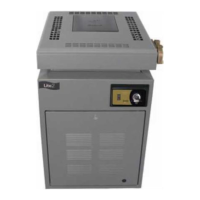Model LJ Pool and Spa Heater
Page 17
• Never deposit chemicals directly in the pool
skimmer.
SECTION 6.
Electrical
WARNING
ELECTRICAL SHOCK HAZARD. This heater
contains wiring that carries high voltage.
Contact with these wires may result in severe
injury or death.
AVERTISSEMENT
POSSIBILITÉ DE CHOCS ÉLECTRIQUES. Ce
système de chauffage contient du filage de
haut voltage. Un contact avec ces fils peut
résulter en des blessures sérieuses ou la mort.
CAUTION
Label all wires prior to disconnection when
servicing controls. Wiring errors can cause
improper and dangerous operation.
Verify proper operation after servicing.
ATTENTION
Au moment de l'entretien des commandes,
étiquetez tous les fils avant de les débrancher.
Des erreurs de câblage peuvent entraîner un
fonctionnement inadéquat et dangereux.
6.1 General Information
Wiring connections must be made exactly as
shown in the wiring diagram found on the inside of the
heater (see Figure 16A) . The heater must include a
definite means of grounding. There is a bonding lug on
the right side of the heater, where a bond wire must be
attached.
The LJ heater controller has a built-in time clock
to run the pump, so an external time clock is not
needed. To utilize the internal time clock, instead of an
external time clock, the power for the pump must be
wired through the heater. A separate relay must be
added to correctly wire the power to the pump. The
relay may be purchased from your local Jandy distribu-
tor. Jandy Pool Products, Inc. recommends the use of
Jandy part number R0658100 because it is supplied
with the wire harness that is needed to connect the
relay to the power circuit board.
6.2 Main Power
Electrical wiring must be in accordance with the
latest edition of the National Electric Code (NEC),
ANSI/National Fire Protection Association (NFPA)
70, unless local code requirements indicate otherwise.
The heater comes factory-wired intended for
use with 230 Volt, 60 Hz AC field electrical
supply. To use 115 Volt, 60 Hz AC requires a
different wiring configuration for the pump. This
must be done by a certified electrician only, as with all
wiring. To wire the heater and pump for 115V, 60 Hz
AC, follow the alternate 115V wiring method depicted
in Figure 16. The ends of the power conversion plug
are color coded. The blue end of the plug is intended
for use with a 230 VAC power supply and the white
end of the plug is intended to be used with a 115 VAC
power supply. The power conversion plug on the
power circuit board (see Figure 16) must be removed
from the board, the orange tape must be removed from
the white end of the plug, and then the white end
inserted into the receptacle on the power circuit board.
This will convert all power in the heater to 115 VAC.
To wire the Lite2 model LJ heater to a 115 V or
230 V / 60 Hertz (Hz) electrical source:
1. Be sure that the power supply to the heater is
off.
2. Remove the door of the heater.
3. Remove the screws that hold the cover to the
power connection box located in the upper right
corner of the heater. Remove the cover.
4. Check the power conversion plug to be sure that
the correct side is plugged into the power circuit
board to match the voltage supplied to the heater.
Each side of the plug is labeled accordingly.
NOTE: The blue side of the power conversion
plug is used for 230V and the white side is used
for 115 V.
5. The heater is shipped with test wires connected
to the “Power In” terminals on the power circuit
board. They are black and red and emerge from
the heater through a hole on the right side.
Before connecting the power source, remove
these wires and discard them.
NOTE: As an alternate method for connecting
the power you may do the following:
When connecting 230 VAC, match the wire
colors from the power supply to the wire colors
of the test wires. Connect the wires using wire
nuts. When connecting 115 VAC, connect the
black wire of the power supply to the black test
wire on the side of the heater and connect the
white wire of the power supply to the red test
wire. Use wire nuts to secure the connections.
6. Run the wires from the power source through the
hole on the right side of the heater. Connect the
wires to the "Power In" terminals on the power
circuit board. The connection will be made inside
the heater and enclosed in the power connection

